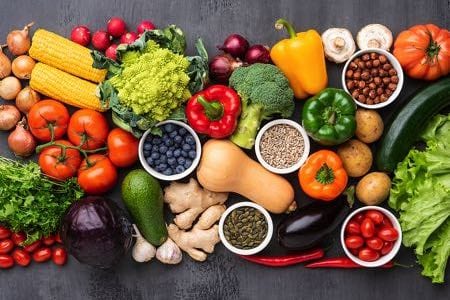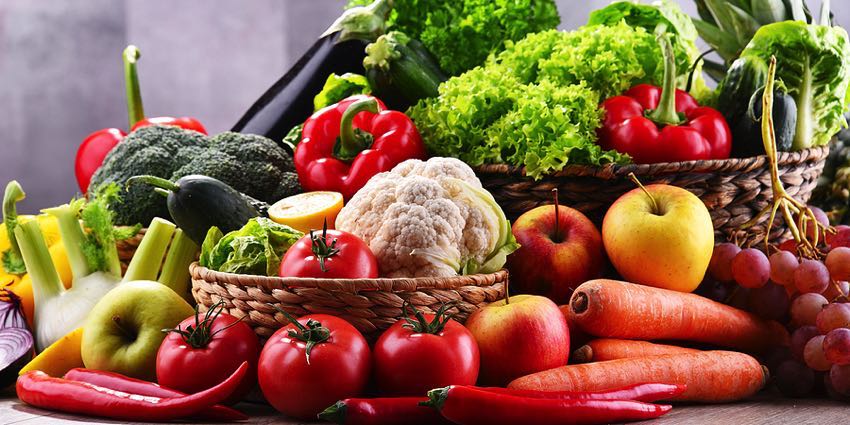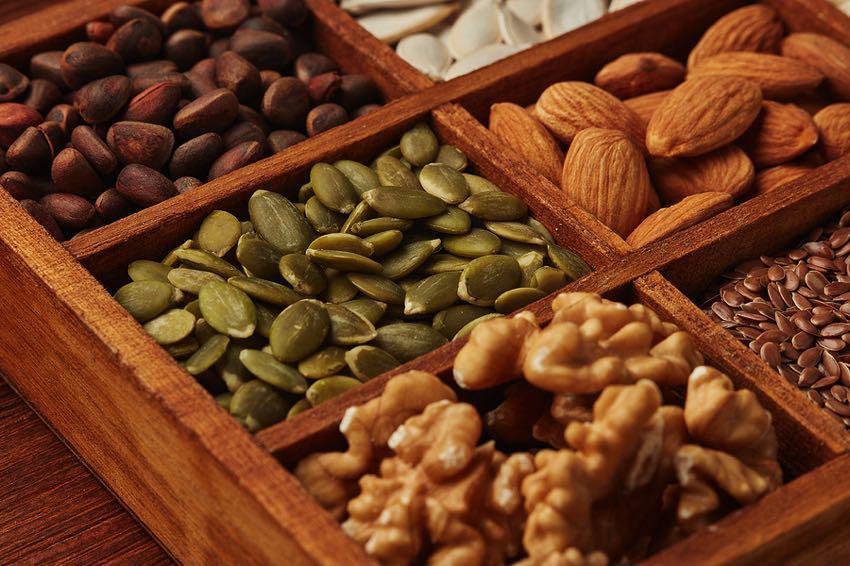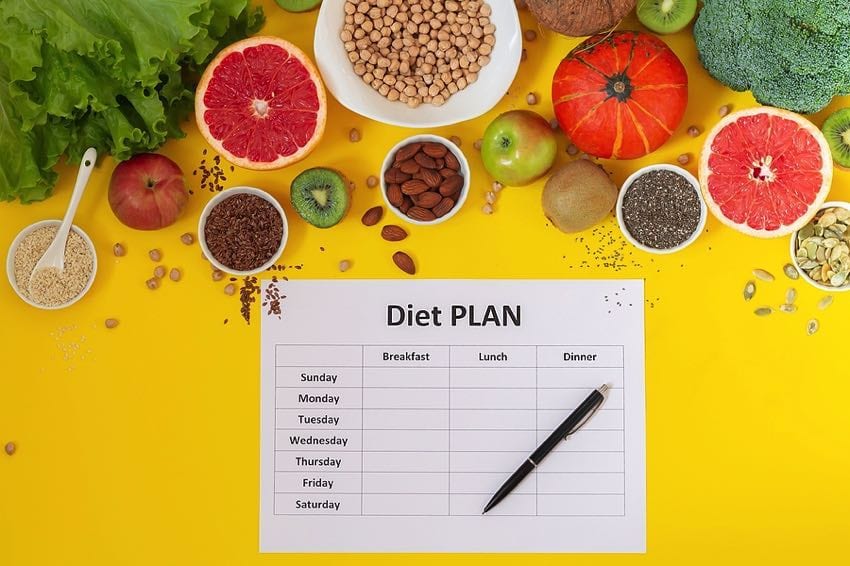 We have said many times on this site that there is no such thing as a single vegan diet. Beyond meaning that a person does not consume animals, foods derived from animals, or substances that have in some way harmed or exploited them, a “vegan diet” can be anything. Someone could eat nothing but high-fat vegan ready meals and be following a vegan diet. Another person could live off vegan protein powder and vegan chocolate (it would be a strange diet admittedly!). And yet another person might follow a raw vegan diet, eating mainly simple, unprocessed plants.
We have said many times on this site that there is no such thing as a single vegan diet. Beyond meaning that a person does not consume animals, foods derived from animals, or substances that have in some way harmed or exploited them, a “vegan diet” can be anything. Someone could eat nothing but high-fat vegan ready meals and be following a vegan diet. Another person could live off vegan protein powder and vegan chocolate (it would be a strange diet admittedly!). And yet another person might follow a raw vegan diet, eating mainly simple, unprocessed plants.
The point is that there are many different types of vegan diets. We have looked at a number of the major ones elsewhere on the site, including the vegan keto diet and the aforementioned raw vegan eating regimen, as well as looking at vegan weight loss. Now it is the turn of the vegan paleo diet, a concept that some have even questioned is possible.
What Is Vegan Paleo?

If you are already familiar with the paleo diet and the concept of vegan paleo, you might want to skip below to the section Is Vegan Paleo Possible?. On the other hand, if you want to start at the beginning, then here you are. So, what is vegan paleo?
Well, unsurprisingly it is a vegan version of the paleo diet, the oldest new diet on the block. Or should that be the newest old diet? Either way, such an explanation begs the obvious question: what is a paleo diet?
The History
A Palaeolithic (paleo is just the shortened version) diet takes its name from the Palaeolithic era, often spelt Paleolithic. Sometimes referred to as the Old Stone Age, this period ran from around two to three million years ago up until approximately 12,000 years ago, so a huge proportion of humanity’s existence.
The diet is said to broadly mimic what humans ate in that period, the simple logic being that such a diet is what humans evolved to eat. Of course, there was a large degree of variety in the diets eaten over a period of more than two million years in different parts of the world (not least because some plants simply don’t grow in certain climates). However, as we are talking about a period of pre-history, it is safe to say the food underwent virtually no processing and that the diet of one person possessed far more aspects in common with another than there were things that made it different.
Walter L. Voegtlin
Whilst the paleo diet has become far more popular in the last 10 years or so, it is not, like most things under the sun, truly new. The concept of basic diets akin to what our ancient ancestors consumed dates back to at least the 19th century. Moreover, what we now generally refer to as the paleo diet was first publicised as the stone age diet in a book of that name written by Walter L. Voegtlin and published in 1975.
Voegtlin was born in 1904 and is also very well known for his role in developing aversion therapy as a treatment for alcohol addiction. He was trained as a gastroenterologist though and his work in this area led him to advocate a diet that eschewed foods that had been farmed. Some of his stranger claims included advocating the mass slaughter of dolphins, tigers and bears but in general he suggested a diet of foods that could be hunted, gathered or fished.
On that basis, it is quite easy to see why vegans may question how a plant-based paleo diet might work. Take away the hunting and fishing (which is nothing more than aquatic hunting really), and you are left with… gathering. On the face of it that doesn’t sound like the metaphorical recipe for a tasty or nutritious diet. We’ll return to that issue shortly but for now, let us explain more about the paleo diet and vegan paleo diet.
Key Principles
The key principles of the paleo diet can be summarised thus:
- The Paleolithic diet is sometimes referred to as the caveman diet, Stone Age diet or hunter gatherer diet
- It mainly consists of fruit, vegetables, nuts, seeds, eggs, fish and meat (obviously these last three items are not part of the vegan paleo diet)
- It includes no dairy
- No cereals/grains/legumes are included
- No processed food are included (though fermented and cultured foods are usually allowed)
- No added salt or sugar is included
Similar to a Raw Diet
Obviously the paleo diet is not legally described and there is no official text or authority that sets out exactly what you can and cannot eat. As such, there are plenty of of grey areas and, as with some vegan issues, certain things come down to personal choice. In the paleo diet, such items include eggs, which some non-vegan paleo adherents do not eat, certain starchier vegetables and higher sugar fruits, and natural sweeteners, such as maple syrup or honey (though again, the latter would be excluded for a vegan paleo as honey is not vegan). The level of processing that is tolerated also varies, whilst the use of salt, dried herbs and spices is also an issue on which some paleo eaters disagree.
None the less, at its core a paleo diet has a lot of similarities with a raw diet, whilst also taking some elements of a keto eating plan. So, a vegan paleo diet is simply as described above but without the non-vegan elements, chiefly meat, eggs and fish, as well as other animal-derived foods, such as honey.
Is Vegan Paleo Possible?
Vegan paleo is possible, of course. As we have alluded to it is possible to eat only vegan chocolate if you want. Quite how long you will live and how healthy those years will be is, of course, another matter. Better questions, therefore, might be: is it advisable for a vegan to follow a paleo diet and is a vegan paleo diet healthy?
Eating a Varied Range of Foods is Advisable
As a general rule, most nutrition experts believe that eating as varied a range of foods as possible is the healthiest way to be. Any restrictive diet that says you cannot eat certain foods is, therefore, typically treated with a little caution. Of course, veganism itself is a restrictive diet and whilst we cannot say with absolute certainty that a non-vegan diet, with very small amounts of animal-based foods, is not perhaps the healthiest option, many vegans are not solely motivated by health.
That said, there are many excellent health reasons for going vegan and vegans do avoid many of the negative health outcomes associated with eating animal products. In general, they have a lower BMI and most importantly of all, there is little doubt that a well-planned, healthy, varied vegan diet can and does provide all the key nutrients we need for optimal health.
The Paleo Diet Can Be Restrictive
But the paleo diet is far more restrictive than a vegan diet and, to make matters worse, many of the nutrients that we require are caught at the intersection of the two. By that, we mean that there is a range of vitamins and minerals that are found in meat and other animal products that vegans typically get from the very foods that the paleo diet excludes.
Various micronutrients, as well as protein, are often consumed by vegans in the form of legumes and grains. Even the pseudo-grain quinoa is off the menu for a paleo dieter, whilst other vegan staples such as chickpeas, lentils, peas, kidney beans and the wonderfully versatile and magnificently nutritious soyabean are also off limits.
How Do Vegans Eat Paleo?
Given the above, it is hard to envision a vegan paleo diet that would truly be healthy. However, if you do want to give the vegan paleo diet a try, how should you go about it? Well, it is not without its benefits.
The Benefits
On a vegan paleo diet, it would be virtually impossible to avoid consuming lots of fruit and vegetables, especially many of the ones considered to be among the healthiest, such as leafy greens. In addition, nuts and seeds would provide various healthy fats and also decent amounts of protein.
Clearly, avoiding refined and processed foods is also a benefit as these typically contain unhealthy levels of sugar, salt and/or fat. In addition, minimal processing means more of the nutrients remain intact. So far, so good.
The Downside
However, the fact remains that this is a restrictive diet and many of the foods that cannot be eaten are widely considered to be among the healthiest foods there are. Just about every major, respectable health and nutrition authority, including the NHS, advises eating substantial amounts of starchy carbohydrates, including grains and cereals. Equally, they similarly advise eating the very legumes that are out of the question for paleo followers.
Indeed, the NHS specifically state (not even concerning vegans or vegetarians, just as advice for a healthy diet) that “Pulses, such as beans, peas and lentils, are good alternatives to meat because they’re lower in fat and higher in fibre and protein, too.” Having two broad types of healthy foods unavailable is a severe limitation to a diet that already avoids animal products, so how do vegan paleo dieters get on?
Ensuring Sufficient Protein

The vast majority of western diets consume plenty of protein so it is rare for this to be an issue. However, a vegan diet with no legumes, grains or cereals could be an issue, especially as paleo eating rules out processed foods, such as vegan protein powders and shakes.
Nuts & Seeds
Well, the key foods in this regard are nuts and seeds. These are foods that most people should be eating every day but only in moderation due to their high calorie and fat content. However, if you want to follow a paleo vegan diet then you could certainly eat them in greater quantities. It is often recommended that we eat an ounce (28g) of nuts per day, with some sources saying up to two ounces is fine.
Two ounces of almonds, for example, would provide around 12g of protein. Seeds often have even more protein and less fat, so eating two or even three ounces of these a day would also provide a nice protein boost, with pumpkin seeds serving up over 9g of protein per ounce. According to the British Heart Foundation, the average woman needs 45g of protein and they could get 39g of that through the nuts and seeds we have detailed above.
Vegetables
Many vegetables permitted on the paleo diet also contain small but significant amounts of protein and as your diet is going to consist of a lot of veg, this soon adds up. The table below shows how you can easily get more than 50g of protein on a vegan paleo diet. Note that a typical “one of your five-a-day” serving of veg (or fruit) is usually 80g but we have used 100g servings here due to the nature of this diet… and mathematical convenience!
| Food | Serving size (g) | Protein (g) |
|---|---|---|
| Almonds | 56 | 12 |
| Pumpkin seeds | 84 | 27 |
| Asparagus | 100 | 2 |
| Artichoke | 100 | 3 |
| Brussels sprout | 100 | 3 |
| Jackfruit | 100 | 1.5 |
| Dried agar seaweed | 50 | 3 |
| Spinach (and many greens) | 100 | 3 |
As you can see, perhaps surprisingly, protein can be garnered on a vegan paleo diet, with pretty much all veg offering a gram or two (or three) per 100g serving. That easily adds up in a diet packed with plants and spinach is just one green that is a great addition to this diet.
Foraging has become an increasingly popular activity and is a great choice for vegans as you are obtaining wild food for free. One of the most abundant “weeds” in the UK is the stinging nettle and it is surprisingly nutritious. Nettles contain almost 35% protein, as well as decent levels of “vitamin A, vitamin C, calcium, iron …”.
Spirulina on Vegan Paleo?
Another way to get protein and other key micronutrients on a vegan paleo diet is to consume spirulina. Some proponents of paleo would say this is a processed supplement but others would say that the actual processing is minimal. Essentially, spirulina is just dried and powdered algae and it is not inconceivable that our ancestors would have eaten similar foods.
Some class spirulina as a vegan protein powder and it does deliver a hefty 65g of protein per 100g. However, due to the huge range of other micronutrients, it contains it is typically viewed more as a vegan supplement. It may be a grey area for some followers of a paleo diet but as the table below shows, it really is a magnificent way to boost your intake of vitamins and minerals.
| Nutrient | % of Recommended Daily Intake |
|---|---|
| Vitamin A | 11 |
| Vitamin B1 | 250 |
| Vitamin B2 | 250 |
| Vitamin B3 | 72 |
| Vitamin B6 | 50 |
| Vitamin B9 | 25 |
| Vitamin B12 | 16000* |
| Vitamin C | 17 |
| Vitamin E | 60 |
| Calcium | 15 |
| Copper | 680 |
| Chromium | 700 |
| Iodine | 1000 |
| Manganese | 130 |
| Magnesium | 83 |
| Phosphorus | 25 |
| Potassium | 70 |
The amounts above are based on 100g of spirulina. Whilst this is far more than most people would consume in a day, even a 10g serving would provide an extra 6.5g of protein and worthwhile amounts of many vitamins and minerals.
*Whether spirulina is a good source of vitamin B12 has been disputed by various research studies which suggest the B12 in spirulina is an analogue or pseudo vitamin that cannot be well utilised. But the jury is out as other research has validated spirulina as a valid source of bioavailable B12.
To Sprout or Not to Sprout?
Another grey area that is sure to be of interest to vegans wanting to adopt a paleo diet concerns whether or not eating sprouted legumes is acceptable. Part of the argument against some non-paleo foods is that they contain lectins but it is thought by many that by soaking and/or sprouting some legumes and grains, the impact of these anti-nutrients is lessened.
Some experts on paleo believe that sprouted grains are probably a better bet than sprouted legumes. The latter are still thought to contain saponins, other compounds which, so the theory goes, are incompatible with the way our digestive systems have evolved.
One thing is certain, as far as a conventional understanding of nutrition goes, adding sprouted grains and legumes to a vegan paleo diet would certainly help the diet deliver the vitamins and minerals that are necessary for good health. Most paleo diets do allow for some wriggle room in terms of permitting a small proportion of one’s calories to come from non-paleo sources. Therefore if you do want to try the vegan paleo approach, sprouted foods would seem a good area to allow some flexibility with the strictest principles.
What Nutrients Are Lacking in Vegan Paleo? Is It Healthy?
The paleo diet is not one that many major nutritional bodies endorse and it is easy to see why given it excludes many of the foods that are typically considered to be among the healthiest. There are few or no studies about the vegan paleo diet specifically as it remains a niche diet within a niche diet but being even more restrictive it is highly likely to be lacking in certain nutrients.
Lacking in Vitamin D & Calcium
A major US healthcare provider suggested that the standard (that is to say non-vegan) paleo diet “puts most at risk for deficiencies in calcium and vitamin D”. It also seems likely that on the vegan paleo diet, certain B vitamins, iron, iodine and zinc may also be lacking.
Vitamin D needs may not be met by the diet anyway but exposure to as much natural daylight and sunlight as possible could help to offset that issue. Calcium is something that the vegan paleo diet may actually be fine in regards to due to the relatively high calcium found in leafy greens and some nuts. Zinc and iron can also be found in nuts, seeds, and some greens and other veg. Due to the lack of so many other foods, those eating in this way will have to eat more of these healthy items and so, in fact, the vegan paleo diet may not be as deficient as one might assume.
Planning Is Necessary

In addition, whilst not eating meat and animal products makes some nutrients harder to obtain, in lots of ways it is also far healthier. UC Davis Health state that (on a paleo diet), “saturated fat and protein can be consumed far above recommended levels, increasing the risk of kidney and heart disease and certain cancers.” These are not issues likely to be faced by someone on a vegan paleo diet.
The vegan paleo diet clearly has some positives: chiefly that anyone on it will be forced to eat a lot of fruit, vegetables, nuts and seeds. A healthy vegan paleo diet may be possible with great planning, the use of spirulina (great for B vitamins) and a little flexibility about the strictness of the regimen in certain areas.
However, we would advise speaking to a medical professional and/or a trained nutritionist before embarking on such a diet. Quite simply, with so many foods on the dietary naughty step, this is a restrictive way of eating that will be both difficult to stick to and tricky to make work.